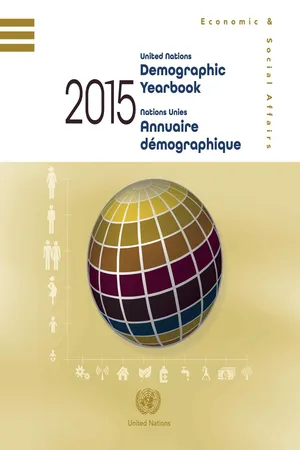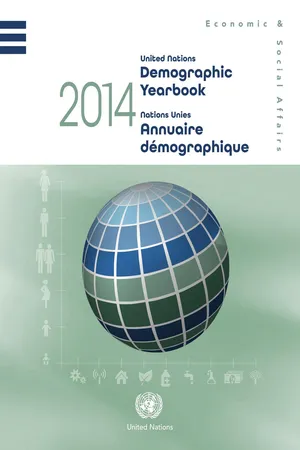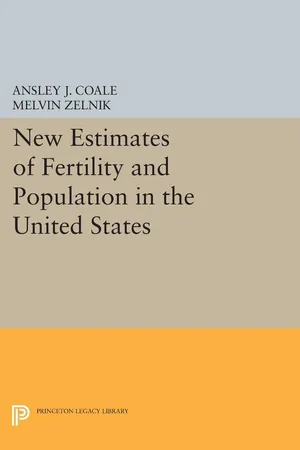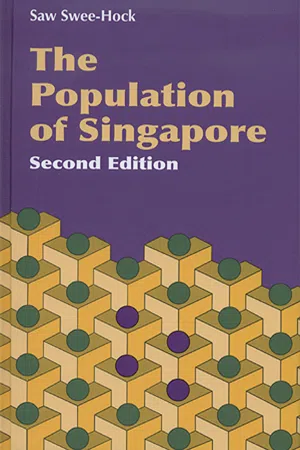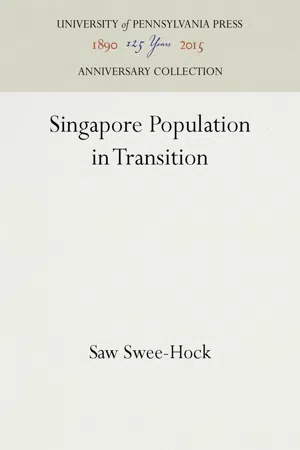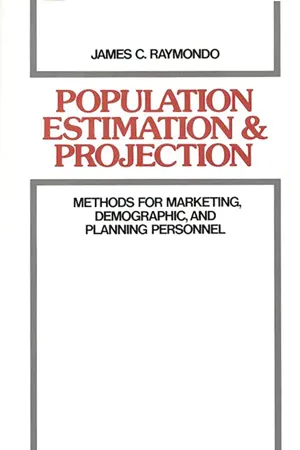Social Sciences
Birth Rates
Birth rates refer to the number of live births per 1,000 people in a given population over a specific period, usually a year. It is a key demographic indicator that reflects the fertility level of a population. High birth rates can lead to population growth and potential strain on resources, while low birth rates can impact workforce and economic growth.
Written by Perlego with AI-assistance
Related key terms
1 of 5
9 Key excerpts on "Birth Rates"
- No longer available |Learn more
United Nations Demographic Yearbook 2015
Sixty-sixth issue
- United Nations Department of Economic and Social Affairs(Author)
- 2017(Publication Date)
- United Nations Publications(Publisher)
Table 9 -Demographic Yearbook 2015 Table 9 presents live births and crude Birth Rates by urban/rural residence for as many years as possible between 2011 and 2015. Description of variables: Live birth is defined as the complete expulsion or extraction from its mother of a product of conception, irrespective of the duration of pregnancy, which after such separation, breathes or shows any other evidence of life such as beating of the heart, pulsation of the umbilical cord, or definite movements of voluntary muscles, whether or not the umbilical cord has been cut or the placenta is attached; each product of such a birth is considered live-born 1 . Statistics on the number of live births are obtained from civil registers unless otherwise noted. For those countries or areas where civil registration statistics on live births are considered reliable the Birth Rates shown have been calculated on the basis of registered live births. For certain countries, there is a discrepancy between the total number of live births shown in this table and those shown in subsequent tables for the same year. Usually this discrepancy arises because the total number of live births occurring in a given year is revised but not the remaining tabulations. Rate computation: Crude Birth Rates are the annual number of live births per 1 000 mid-year population. Rates by urban/rural residence are the annual number of live births, in the appropriate urban or rural category, per 1 000 corresponding mid-year population. Rates are calculated only for data considered complete, that is, coded with a “C” and for estimates and live births statistics for the 12 month period prior to the census date, coded with a “|”. These rates are calculated by the Statistics Division of the United Nations based on the appropriate reference population (for example: total population, nationals only, etc.) if known and available. - No longer available |Learn more
United Nations Demographic Yearbook 2014
Sixty-fifth issue
- United Nations Department of Economic and Social Affairs(Author)
- 2015(Publication Date)
- United Nations Publications(Publisher)
Table 9 -Demographic Yearbook 2014 Table 9 presents live births and crude Birth Rates by urban/rural residence for as many years as possible between 2010 and 2014. Description of variables: Live birth is defined as the complete expulsion or extraction from its mother of a product of conception, irrespective of the duration of pregnancy, which after such separation, breathes or shows any other evidence of life such as beating of the heart, pulsation of the umbilical cord, or definite movements of voluntary muscles, whether or not the umbilical cord has been cut or the placenta is attached; each product of such a birth is considered live-born 1 . Statistics on the number of live births are obtained from civil registers unless otherwise noted. For those countries or areas where civil registration statistics on live births are considered reliable the Birth Rates shown have been calculated on the basis of registered live births. For certain countries, there is a discrepancy between the total number of live births shown in this table and those shown in subsequent tables for the same year. Usually this discrepancy arises because the total number of live births occurring in a given year is revised but not the remaining tabulations. Rate computation: Crude Birth Rates are the annual number of live births per 1 000 mid-year population. Rates by urban/rural residence are the annual number of live births, in the appropriate urban or rural category, per 1 000 corresponding mid-year population. Rates are calculated only for data considered complete, that is, coded with a “C” and for estimates and live births statistics for the 12 month period prior to the census date, coded with a “|”. These rates are calculated by the Statistics Division of the United Nations based on the appropriate reference population (for example: total population, nationals only, etc.) if known and available. - Saw Swee-Hock(Author)
- 2005(Publication Date)
- ISEAS Publishing(Publisher)
8 Rapid Fertility Decline Having examined at great length the nature of the population control programme with its various components introduced at different times in response to prevailing demographic trends and economic conditions, we will now proceed to investigate the levels and trends in fertility during the post-war period up to 1977, paying particular attention to the more interesting developments that have taken place in the seventies. In this task we have been greatly assisted by the availability of accurate and comprehensive birth statistics 1 generated from the efficient vital registration system in Singapore. For one thing, the coverage of birth statistics is known to have attained near 100 per cent completeness, and from 1953 these data have been made available according to the date of occurrence of live-births. Data on live-births by age of mother have been made available progressively in greater detail since 1943, with birth order statistics first published in 1967. Our study of fertility levels and trends is based largely on the total fertility rate though the crude birth rate is also used. The crude birth rate, defined as the total number of live-births occurring during one calendar year per thousand population living in the middle of the same year, is easy to compute and understand, but it suffers from some inherent defects. It is distorted by differences in population structure and is not suited for assessing fertility differences over time or among various groups of the population. The total fertility rate is the average number of children that would be born per woman in a group of women if all women survived to the end of their reproductive years and bore children at each age in accordance with the age-specific fertility schedule for women of various ages.- eBook - PDF
- Angus M. Gunn(Author)
- 2013(Publication Date)
- Pergamon(Publisher)
The core of the campaign is focused in radio, television, and mobile vans. A jingle in calypso (lilting, entertaining and good for dancing) is broadcast by radio, calling on brother, sissie, baba and mama to rise in the census week and be counted. Won't my children die, if they are counted? a section of the population thinks, so the census promotion teams explain that no disease will come to them as a result of the count. In another area of the country, elderly persons are spoken of in the plural'. This is being overcome by requesting them to describe themselves for the purpose of the census as big man (or woman) and the ego is satisfied. Then there are the serious problems of the purdah. Moslem men seclude their wives from public view, and males other than their husbands cannot reach them in their rooms. Female enumerators visit the harems, and Moslem tradition is honoured. Polygamous families are not so difficult, but the head of the household may forget the number of his children if he has several wives. World Birth and Death Rates A country's population and its rate of natural increase is largely a result of the numbers of people who are born and who die in thcrt country. The numbers of births and deaths are usually expressed as rates. Rates measure the frequency of births or deaths in a specific population during a given period of time, generally a year. Crude = births per year , 00Q birth rate population ' Crude _ deaths per year , nnn death rate population i,uuu The rate of natural increase is the difference between birth and death rates. Since birth and death rates are measured per 1,000 population, the birth minus death difference is divided by 10 to convert to a percentage. Rate of (birth rate - death rate) natural = 10 increase The annual growth rate of a country is calculated by subtracting crude death rate from crude birth rate, then adding net immigration (immigrants - emigrants per 1,000 population) and dividing by 10 to obtain a percentage. - Ansley Johnson Coale, Melvin Zelnik(Authors)
- 2015(Publication Date)
- Princeton University Press(Publisher)
under-registration; (2) from 1855 to 1934, when our birth estimates are available; and (3) prior to 1855, when the Thompson-Whelpton estimates of births for five-year intervals centered on census dates are employed. For the most recent period we obtained a figure for total fertility by multiplying the officially calculated Gross Reproduction LONG-TERM FERTILITY TRENDS A COMPARISON OF TRENDS IN TOTAL FERTILITY The birth rate is a measure of the fertility of the population as a whole. It reflects such influences as unusually plentiful or sparse proportions of women at the most fertile ages in addition to the number of children each woman bears. In contrast, the total fertility rate is a measure unaffected by such influences as the age distribution, and reflects childbearing performance only. It summarizes the production of births per woman passing through life, rather than the rate of occurrence of births in the whole population. Specifically, total fertility is the average number of children per woman that would be born to a hypothetical group subject at each age to the childbearing rate experienced in the observed population. Thus the total fertility of 2.1 in 1936 among white women in the United States means that women bearing children at 1936 rates would reach meno- pause having experienced an average of 2.1 births apiece. We have estimated the course of total fertility in the United States since 1800 (Table 2; Figure 10). During all but the most Rate by one plus the sex ratio at birth for the year in question, and by the ratio census estimate of women 20-39 T ~ . «ε · , , ,. — — In effect, omcial data were adjusted for census our estimate of women 20-39 undercounts of women of childbearing age. For the earlier periods, we made use of equation (6), p. 71, Chapter 6. It follows from this equation that F = G(i3 — a), provided that there is no corre- lation between the age distribution and the fertility schedule over the childbearing span.- eBook - PDF
The Population of Singapore
(2nd Ecition)
- Saw Swee-Hock(Author)
- 2007(Publication Date)
- ISEAS Publishing(Publisher)
Even so, the births for the pre-war years were not tabulated according to the age of mothers, and hence the superior fertility indices such as the gross reproduction rate (GRR) and the total fertility rate 151 152 POPULATION OF SINGAPORE (TFR) cannot be calculated. What we can derive is the crude birth rate defined as the number of births per thousand population. In utilising the statistics, we have also decided to present the births and the computed crude birth rate in Table 8.1 in terms of five-year periods in order to remove the somewhat erratic annual fluctuations and to enable us to focus our attention on the long-term movements. The population denominator adopted to calculate the rates refers to the average of the five mid-year populations in each given period. TABLE 8.1 Annual Average Births and Crude Birth Rates, 1876–2005 Period Annual Average Births Crude Birth Rates 1878–80 835 6.5 1881–85 2,201 15.0 1886–90 2,770 16.4 1891–95 3,310 17.3 1896–00 3,835 17.1 1901–05 5,113 21.2 1906–10 6,051 22.3 1911–15 7,693 23.9 1916–20 9,819 26.5 1921–25 13,418 29.5 1926–30 18,991 34.3 1931–35 22,280 40.5 1936–40 31,643 45.9 1941–45 29,897 36.5 1946–50 43,738 44.8 1951–55 53,693 47.8 1956–60 61,877 41.0 1961–65 58,476 33.4 1966–70 48,595 24.2 1971–75 45,650 20.8 1976–80 40,517 17.2 1981–85 41,906 16.8 1986–90 46,753 17.3 1991–95 49,386 15.1 1996–00 45,981 11.9 2001–05 38,872 9.2 Fertility Trends and Differentials 153 The movement in the annual average number of births during the sixty-year period before World War II was clearly upwards without any break. Ignoring the statistics for the first period 1878–80, which were not reliable, the average number of births rose steadily from 2,201 in 1981–85 to 9,819 in 1916–20 and then rapidly to 31,643 in 1936–40. - eBook - PDF
- Henry S. Shryock, Jacob S. Siegel(Authors)
- 2013(Publication Date)
- Academic Press(Publisher)
CHAPTER 17 Natality: Measures Based on Censuses and Surveys Natality data obtained from vital statistics registration systems and the measures derived from them were the subject of the preceding chapter. The present chapter deals with natality data based on national censuses and surveys. As was mentioned in chapter 16, many of the fertility measures derived from birth statistics can be approximated from census data. COMPARISON WITH MEASURES FROM VITAL STATISTICS In addition to supplying denominators for vital rates, population censuses or surveys sometimes provide fertility data to be used independently, either as supplements to vital statistics rates or as substitutes for these rates where birth registration does not exist or is inadequate. Fertility statistics from enumerations can be used to evaluate birth statistics from a registration system, and vice versa. Registration statistics present directly the fertility of a particular time period, usu-ally a month or year, whereas census statistics may also show cumulative fertility patterns over a woman's lifetime. Birth registration records usually provide information on a few demographic characteristics of the parents of children born in the relevant period, whereas census inquiries provide data on characteristics of all women or men enumerated who have ever had children and also, and equally important, on those who have never had children. In general, much more supplementary information of demographic interest can be provided by censuses than by birth records because of the varied kinds of information which are collected in censuses, such as data on socioeconomic characteristics. In addition, there are certain types of informa-tion which can be collected in censuses specifically for use with fertility data. Primarily, these are data on the duration of either the present or the first marriage of women, the date of this marriage, or the age at which it took place. - eBook - PDF
- Saw Swee-Hock(Author)
- 2016(Publication Date)
1 The figures highlight a steady rise in the Birth Rates without any major interruption from about 15 to 46 per thousand population during the span of about sixty years from 1878 to 1940. This was followed by a temporary decline to about 37 during the Japanese occupation period 1941—45, and thereafter a quick recovery and the maintenance of the rate well above the level of 40 in the postwar years. In the last couple of years there has been recorded a drop in the birth rate as 1 The population denominator adopted in the calculation of the rate refers to the average of the five mid-year populations in each given quinary period. 71 TABLE 6.1 ANNUAL AVERAGE BIRTHS AND CRUDE Birth Rates, 1878-1965 Quinary Period Annual A v e r a g e Births Crude Birth R a t e s 1 8 7 8 -8 0 8 3 5 6 . 5 1 8 8 1 -8 5 2 , 2 0 1 1 5 . 0 1 8 8 6 -9 0 2 , 7 7 0 1 6 . 4 1 8 9 1 -9 5 3 , 3 1 0 1 7 . 3 1 8 9 6 -0 0 3 , 8 3 5 17.1 1 9 0 1 -0 5 5 , 1 1 3 2 1 . 2 1 9 0 6 -1 0 6 , 0 5 1 2 2 . 3 1 9 1 1 -1 5 7 , 6 9 3 2 3 . 9 1 9 1 6 -2 0 9 , 8 1 9 2 6 . 5 1 9 2 1 -2 5 1 3 , 4 1 8 2 9 . 5 1 9 2 6 -3 0 1 8 , 9 9 1 3 4 . 3 1 9 3 1 -3 5 2 2 , 2 8 0 4 0 . 5 1 9 3 6 -4 0 3 1 , 6 4 3 4 5 . 9 1 9 4 1 -4 5 2 9 , 8 9 7 3 6 . 5 1 9 4 6 -5 0 4 3 , 7 3 8 4 4 . 8 1 9 5 1 -5 5 5 3 , 6 9 3 4 7 . 8 1 9 5 6 -6 0 6 1 , 8 7 7 4 1 . 0 1 9 6 1 -6 5 5 8 , 4 7 6 3 2 . 9 well as in the number of births, an exhaustive analysis of which will be presented in the next section. The continuous upward trend in the Birth Rates recorded during 1878-1940 from an initial low level seems to be in direct contrast to the experi-ence of most European countries where the trend during the same period was predominantly downward from an initial high level. 2 But, while the downward movement in these countries was the result of a genuine fall in fertility, the upward trend in Singapore was caused not so much by a rise in fertility as by a normalizing of the sex ratio and by a gradual improve-ment in the completeness of birth registration. - eBook - PDF
Population Estimation and Projection
Methods for Marketing, Demographic, and Planning Professionals
- James Raymondo(Author)
- 1992(Publication Date)
- Praeger(Publisher)
SUMMARY This chapter discussed the basic demographic concepts of fertility, mortality, and migration that in part form the foundation of population estimates and projections. Several measures of fertility were discussed, including the crude birth rate, the child woman ratio, the general fertility rate, and age specific fertility rates. Each of these measures has advantages and disadvantages associated with it, and each may be employed in the production of population estimates and projections. A variety of mortality measures also was discussed in this chapter. The crude death rate, age specific death rates, and infant mortality rates are among the major measures of mortality from which one will select when producing population estimates or projections. Again, each of these Population Concepts and Measures 41 measures has its advantages and disadvantages, and there is no simple answer to the question "Which measure of mortality is the best to use?" The discussion of migration measures completed our consideration of the three classic demographic variables; as in the situation with fertility and mortality, there are choices to make with respect to measures. Data availability plays more of a role in the selection of a migration measure than it does for fertility or mortality. The intercensal component method and the reverse survival rate method were each discussed, and either may be acceptable choices for population estimates or projections that do not require detailed results. The production of detailed population estimates or projections will usually require the use of the reverse survival rate method. The Final Choice of Measures There is no simple single choice of a population indicator that will be considered the best measure in all situations.
Index pages curate the most relevant extracts from our library of academic textbooks. They’ve been created using an in-house natural language model (NLM), each adding context and meaning to key research topics.
